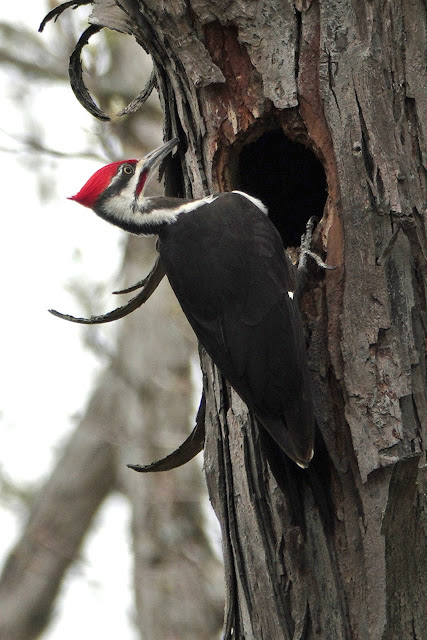The latest is a special surprise, the pileated woodpecker.
 |
| Lisa Culp Musgrave photographed this recently-returned, nesting pileated woodpecker at Deer Grove. It is now nesting season. Might they be nesting in Somme Woods too? |
 |
| For your amusement, I photographed the Somme pileated. With my cell phone! Can you see it? On the base of that log? |
| Okay, here's the blow up of my cell photo. Not the best? But sure enough, there is a pileated woodpecker in Somme! |
Normally, this spectacular crow-sized woodpecker is found in very large, old, open woods. Before last evening, we’d never seen one at Somme.
But it's not a total surprise. Chicagoland Birds by Ellen Thorne Smith (Field Museum 1958, revised 1972) categorized the pileated as “not normally found in the Chicago region.” For recorded occurrences, it shows three dots in spring and six in fall, but not a single dot during the breeding season. The pileated now breeds regularly in the big Palos forest preserves.
For me, the big bird was just part of a delicious adventure. I’d been scything invasive cat-tails from one of the Somme ponds, standing nearly knee deep in clean cool water that increasingly, with our efforts, has fewer and fewer narrow-leaved cat-tail and more and more sweet flag, bur reed, blue-flag iris, yellow floating buttercup, and more. My work with the scythe was surgical, slow, methodical, zen. Animals relaxed. A sora rail called. A green heron appeared. Birds, frogs, and salamanders seem to prefer this "more restored" pond to the nearby, larger, less-restored one.
Suddenly behind me I heard a loud and strange squawk. Now, I know most of the Somme squawks. But this was not a Cooper’s hawk, not a green heron, nor a baby owl. I turned and my jaw dropped. There was one of the few pileated woodpeckers I’d ever seen.
It was clearly talking to me. What was I, it wondered? And why was I there? Then it demonstrated that it had probably watched me for some time, ruled me likely harmless, and knew what it wanted. When it called to me, and I turned and looked, and stayed chill, as it appeared to the pileated, it flew toward me and landed on a downed log, into the pond, and started chopping out large chunks of soft wood.
As I worked, I came across seven red-winged blackbird nests. Two of them were within about three feet of each other. So much nature. It was a happy time.
 |
| Pileated woodpeckers eat mostly ants. Lisa's photo caught its tongue sticking into a hole the bird drilled for ants. The sticky tongue fishes them out. |
 |
| A chicken-like marsh bird with huge feet, the sora nests in Somme every year. |
 |
| Red-winged blackbird eggs in the woodpecker pond's marsh. |
 |
| One last Lisa photo. The green heron eats Somme's large insects, frogs, and salamanders - not too many, we hope. But good habitat provides more for all. |
Thanks to the volunteer restoration heroes who work at Somme,
season after season, year after year after year -
it's a greater and greater place.
Acknowledgements
Thanks to Lisa Culp Musgrave for the good bird photos.

